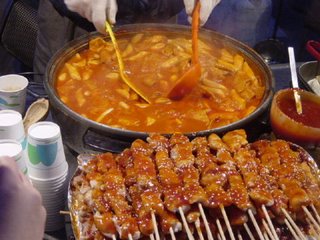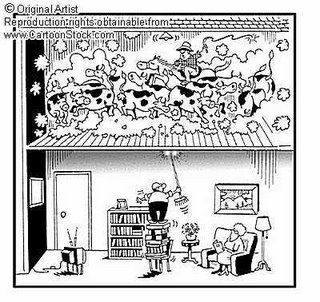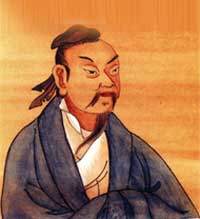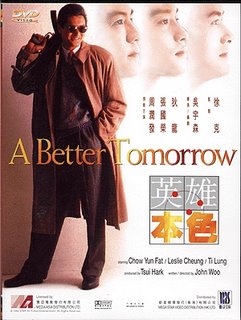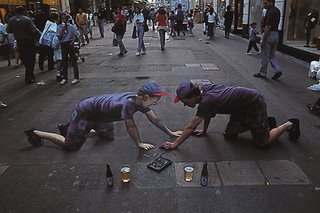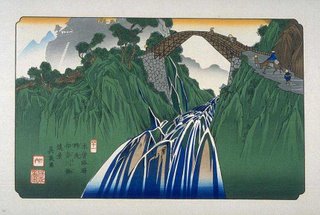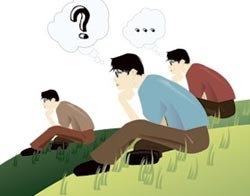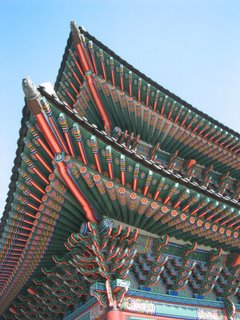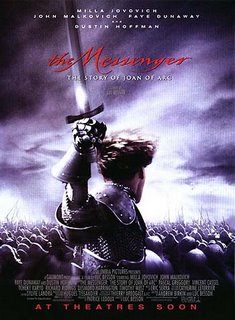
The Early Years
She was born on January 6th around the year 1412, to Jacques and Isabelle d'Arc in the little village of Domremy, in the Barrois region (now part of "Lorraine") on the border of eastern France.
Although at the time she was born a shaky truce was still in effect between France and England, a civil war had erupted between two factions of the French Royal family which would allow the English to re-invade.
One faction, called the "Orleanists" or "Armagnacs", was led by Count Bernard VII of Armagnac and Duke Charles of Orleans (whom Joan would later regard with special warmth); their rivals, known as the "Burgundians", were led by Duke John-the-Fearless of Burgundy. The forces of his pro-English son, Philip "the Good", would later capture Joan and hand her over to the English; one of his loyal supporters, a pro-Burgundian clergyman and English advisor named Pierre Cauchon, would later arrange her conviction on their behalf.
With the French divided into warring parties and negotiations to renew the truce with England a failure, King Henry V invaded France in August of 1415 after reviving his family's faded claim to the French throne. On October 25th an Armagnac-dominated French army was cut to pieces by Henry's forces at the battle of Agincourt.
The English returned in 1417, conquering much of northern France and gaining the support (in 1419) of the new Burgundian Duke, Philip-the-Good, who agreed to recognize Henry V as the legal heir to the French throne while rejecting the rival claim of the man whom Joan would consider the rightful successor, Charles of Ponthieu (later known as Charles VII), the last heir of the Valois dynasty which had ruled France since 1328.
It was around 1424, when she was 12, that Joan said she began to have visions of Saints Catherine and Margaret (two early Christian martyrs) and St. Michael the Archangel (identified in the Bible as the commander of Heaven's armies who led the war against Satan).
Michael had been chosen in 1422 as one of the patron saints of the French Royal army (along with Saint Denis), and had long been the patron of the fortified island of Mont-St-Michel, which had been holding out against repeated English assaults. The rest of northern France was less successful: Charles gradually lost the allegiance of all the important cities north of the Loire River except for Tournai in Flanders and Vaucouleurs, near Domremy. With Paris under occupation since 1418, his court was now located in the city of Bourges-en-Berri in central France, hemmed in by hostile forces on nearly every side: pro-English Brittany to the northwest, English-occupied Normandy to the north, the Burgundian hereditary domains of Flanders, Burgundy, and Franche-Comte to the east and northeast; and the English hereditary domain of Aquitaine to the southwest.
In 1428 the situation became critical, as the English prepared to attack the city of Orleans and thereby gain control over the crucial valley of the Loire River, the northern perimeter of Charles' dwindling domain.
It was at this time, as Joan later said, that she finally obeyed the orders of her saints to lead an army against the English and Burgundians, explaining that God had taken pity on the French for the suffering they had endured. As a child, these visions had merely instructed her to, quote: "be good [or pious], [and] to go to church regularly"; but over the next several years they had persistently called for her to go to the local commander at Vaucouleurs to obtain an escort to take her to the Royal Court.
She said she finally obeyed in May of 1428, and found a way for a family relative, Durand Lassois, to take her to Vaucouleurs to speak with the garrison commander, Lord Robert de Baudricourt, who had remained loyal to the Armagnacs despite being a vassal of the pro-Burgundian Duke of Lorraine. Baudricourt refused to listen to her, and she returned home.
Shortly after her return, in July of 1428, Domremy found itself in the path of a Burgundian army led by Lord Jean de Vergy, forcing the villagers to take refuge in the nearby city of Neufchateau until the troops had passed. Vergy's army laid siege to Vaucouleurs and forced Baudricourt to pledge neutrality.
On October 12th Orleans was placed under siege by an English army under the Earl of Salisbury. The eyewitness accounts and other 15th century sources say that the situation for Charles was rather hopeless by that stage: his treasury at one point was down to less than "four ecus"; his armies were a motley collection of local feudal contingents and foreign mercenaries; and he himself, according to the surviving accounts, was torn with doubt over the validity of his cause - since his own mother, cooperating with the English, had allegedly declared him illegitimate in order to deny his claim to the throne. Now Orleans, the last major city defending the heart of his territory, was in the grip of an English army.
This was the situation facing his government, by that point located in the city of Chinon on the Vienne River, when Joan was finally granted Baudricourt's permission, after her third attempt, to go with an escort to speak with Charles. One account says that she convinced Baudricourt by accurately predicting a French defeat near Rouvray, north of Orleans, when an army under the Count of Clermont unsuccessfully tried to stop an English supply convoy bringing food to the besiegers around Orleans. When Baudricourt was informed of the disaster he promptly arranged for an armed escort to bring Joan through enemy territory to Chinon.
Following the standard procedure, her escorts dressed her in male clothing when camped in the fields with soldiers, for safety and modesty's sake. She would call herself "La Pucelle" (the Maiden or Virgin), explaining that she had promised her saints to keep her virginity "for as long as it pleases God", and it is by this nickname that she is usually described in the documents.
Chinon
After eleven days on the road, she arrived at Chinon around March 4th and was brought into Charles' presence, after a delay of two days, by Count Louis de Vendome.
There are many eyewitness accounts of this event: Lord Raoul de Gaucourt, a Royal commander and bailiff of Orleans, recalled that "...she presented herself before his Royal majesty with great humility and simplicity, a poor shepherd girl, and ... said to the King: 'Most illustrious lord Dauphin, I have come and am sent in the name of God to bring aid to yourself and to the kingdom."
However, Charles first wanted her to be examined by a group of theologians in order to test her orthodoxy, and for that purpose she was sent to the city of Poitiers about 30 miles to the south, where pro-Armagnac clergy from the University of Paris had congregated after Paris came under English occupation a decade earlier. She was questioned for three weeks before they gave her their approval [click here to see the official text of their conclusions] and told Charles that he could grant her titular command of an army - an arrangement which was occasionally given to religious visionaries during the medieval period.
While still at Poitiers she told a clergyman named Jean Erault to record an ultimatum to the English commanders at Orleans around March 22, the first of eleven surviving examples of the letters she dictated to scribes during the course of her military campaigns. In this ultimatum she begins with the "Jesus-Mary" slogan which would become her trademark (borrowed from the Catholic clergy known as mendicants - Dominicans, Franciscans, Carmelites, and Augustinians - who made up a large portion of the priests in her army). She then goes on to inform the English that the "son of Saint Mary" [i.e., Jesus Christ] supports Charles VII's claim to the throne, and repeatedly advises the English to "go away [back] to England" ("allez-vous-en en Angleterre") or she will "drive you out of France" ["bouter vous hors de France"].
The English, in place of a reply, would detain the two men who delivered the message. She would find that more forceful methods would be needed to convince the English to pull their troops out of the Loire Valley.
The Army
After providing her with a suit of armor "made exactly for her body" (in the words of one eyewitness), and a banner with a picture of "Our Savior" holding the world "with two angels at the sides", on a white background covered with gold fleurs-de-lis, they brought her to the army at Blois, about 35 miles southwest of Orleans.
It was here that she began to reform the troops by expelling the prostitutes from the camp (sometimes at sword point, according to several eyewitnesses) and requiring the soldiers to go to church and confession, give up swearing, and refrain from looting or harassing the civilian population.
Her arrival had another valuable effect on the army: men who would otherwise have refused to serve Charles' defeated cause now began to volunteer for the campaign, as word that a saint was now at the head of the army began to change minds.
Orleans
The army moved out from Blois around April 25th and arrived in stages at the besieged city between April 29th and May 4th. A small force had come out to meet them at Checy, five miles upriver from Orleans; but as there weren't enough barges to transport the entire body of troops across the river, Joan herself and a small group of soldiers were escorted into the city by Lord Jean d'Orleans (better known by his later title, Count of Dunois), the man in charge of the city's defense due to his status as the half-brother of the Duke of Orleans. The rest of the army would arrive later by a different route, its numbers greatly reduced by discouraged men who decided to leave without the Maiden there to encourage them.
On May 4th the rest of her troops made it into the city, and a few hours later an assault was launched against an English-held fortified church called Saint Loup, about a mile east of Orleans. The surviving accounts say that the position was carried after Joan rode up with her banner, encouraging the troops up and over the ramparts. The English casualties totaled 114 dead and 40 captured.
Her role in this engagement would become typical: two different sources quote her as saying that she always carried her banner into battle (rather than a weapon, as is sometimes supposed), since, as she explained, she didn't want to harm anyone; and there are many eyewitness accounts which repeatedly describe her encouraging the troops to greater efforts by placing herself in the same danger that they themselves faced.
On the following day she sent her final ultimatum to the English commanders at Orléans, this time having an archer deliver the note with an arrow rather than risk losing another messenger.
The remaining English positions fell swiftly: on May 6th an attack was made against a fortified monastery called the "Bastille des Augustins", which controlled the southern approach to a pair of towers called Les Tourelles, at the southern end of Orleans' bridge. Flanking these to the east was a fortified church called St-Jean-le-Blanc, near which the English had been bombarding the city with one of their largest cannons, called "le Passe-volant".
The French troops were sent over a pontoon bridge around the hour of Tierce (9 a.m.), and induced the English to abandon St-Jean-le-Blanc without a fight; the more substantial fortress of Les Augustins was then assaulted, with the saint leading the initial charge alongside La Hire. The fortress was then stormed and overrun with few losses. This placed Les Tourelles within striking range: during the course of the next morning's assault, Joan herself was wounded by an arrow while helping the soldiers set up a scaling ladder.
It seems she stayed behind the area of fighting for most of the day, but returned to the field near dusk in order to encourage the demoralized troops to one final effort which met with success. This proved to be decisive: the English abandoned the siege the next day, and moved their remaining troops off to Meung-sur-Loire and other positions along the river.
Orleans was the English high-water mark: never again would they come so close to achieving a final victory against Charles, who would soon be anointed as King Charles VII.
The Loire Valley and Reims
The unexpected lifting of the siege led to the support of a number of prominent figures. Duke Jean V of Brittany rejected his previous alliance with the English and promised to send troops to Charles' aid. The Archbishop of Embrun wrote a treatise [June 1429] declaring Joan to be divinely inspired, and advised Charles to consult with her on matters concerning the war.
The joy felt by Charles himself when he and Joan met again at Loches on the 11th was neatly summed up in an account by Eberhardt von Windecken: "... Then the young girl bowed her head before the King as much as she could, and the King immediately had her raise it again; and one would have thought that he would have kissed her from the joy that he experienced."
On the other side, the Duke of Bedford (the chief English commander in France) reacted by calling up as many troops as possible from English-occupied territory; the Duke of Burgundy made plans to take a more active role in helping his allies in the field, although as usual he demanded a modest sum (250,000 livres) to help offset his costs.
After the Dauphin's joyful reunion with the saint, she convinced him to take an army north to Reims to be crowned, as custom required. This was no simple task, since Reims at that time lay deep within enemy-held territory; in order to open a way for a northward campaign, the Royal army first set about the job of clearing out the remaining English positions in the Loire Valley, with the Duke of Alencon being given command of the venture.
The army's first target was Jargeau, ten miles to the southeast of Orleans. At least 3,600 armored troops, plus an unknown number of lightly-armed 'commons', were present for duty. The town was reached on June 11th; the main assault came the next day after an artillery bombardment in which Jargeau's largest tower was felled by a large cannon from Orleans nicknamed "La Bergere" ("the Shepherdess"), presumably named after the saint herself. The latter's role was also crucial: carrying her banner up front with the troops, she was hit in the helmet with a stone but immediately got back on her feet and encouraged the soldiers to storm the ramparts by shouting: "Friends, friends, up! Up! Our Lord has condemned the English". [In the archaic French of the 15th century: "Amys, amys, sus! Sus! Nostre Sire a condempne les Angloys"] The fortifications were taken, and the English were driven back across Jargeau's bridge. The survivors surrendered.
Beaugency was taken on the 17th after the English garrison negotiated an agreement allowing them to withdraw. That evening the English troops at Meung, reinforced by an army under Sir John Fastolf, offered battle to the French but subsequently decided to fall back the next day, riding northward in an effort to make it back to more secure territory. The French pursued (goaded on by Joan, saying in effect that they should use their "good spurs" to chase the enemy); the two armies clashed south of Patay, where a rapid cavalry charge led by La Hire and other nobles of the vanguard overran a line of 500 English archers which had been set up to delay the French as long as they could. Confusion among the main contingents of the English army completed the rout, and the French cavalry swept their opponents from the field. The English heralds announced their losses at 2,200 men, compared to only three casualties for the French - the reverse of so many other battles in that war.
The March to Reims
When Charles met his commanders after this victory, the decision was made to press on northward to Reims. Gathering the army together at Gien on the Loire, both Charles and Joan began sending out letters requesting various cities and dignitaries to send representatives to the coronation.
The Royal army finally moved out from Gien on the 29th, after a delay which caused Joan much distress. The Burgundian-held city of Auxerre was reached the next day, and an agreement with the city leaders was worked out after three days of negotiations: the army was allowed to buy food, and Auxerre agreed to pay the same obedience to Charles as Troyes, Chalons, and Reims chose to do.
The next stop was Troyes, garrisoned by 500-600 Burgundian troops.
On July 4th, at St. Phal near Troyes, she sent a letter to the citizens of the latter city asking them to declare themselves for Charles, adding that "with the help of King Jesus", Charles will enter all of the towns within his inheritance regardless of their wishes.
Troyes initially ignored the summons. While Charles' commanders debated their next course of action, Joan told them to promptly besiege the town, predicting they would gain it in three days "either by love or by force". Lord Dunois remembered that she then began ordering the placement of the troops, and did it so well that "two or three of the most famous and experienced soldiers" could not have done it better. Troyes surrendered the next day without a fight. The Royal army entered on the 10th; by the 14th it had reached Chalons-sur-Marne to the north, which opened its gates with greater promptitude than Troyes.
Reims followed suit after Joan counseled Charles to "advance boldly"; and at last the Dauphin was poised to receive the crown which had been denied him years earlier.
During the ceremony Joan stood near Charles, holding her banner. The memorable words of one 15th century source describes the scene: after Charles was crowned, Joan "wept many tears and said, 'Noble king, now is accomplished the pleasure of God, who wished me to lift the siege of Orleans, and to bring you to this city of Reims to receive your holy anointing, to show that you are the true king, and the one to whom the kingdom of France should belong.'" It adds: "All those who saw her were moved to great compassion."
The Siege of Paris
On July 17th, the day of the coronation, Joan sent a letter to the Duke of Burgundy asking why he didn't bother to show up for the coronation and proposing that he and Charles should, quote, "make a good firm lasting peace. Pardon each other completely and willingly, as loyal Christians should do; and if it should please you to make war, go against the Saracens." (The Islamic Saracens, frequently at war with Christendom, were one of her preferred targets for legitimate military action).
Although the Duke himself stayed away, his emissaries had arrived in Reims on the day of the coronation and began negotiations which resulted in a 15-day truce being declared - not exactly the "good, firm, lasting peace" that Joan wanted, and in fact such a short truce immediately following in the wake of Charles' triumph could serve only to give the English and Burgundians time to regroup.
Charles followed up this treaty by taking his army on a city-by-city tour of the Ile-de-France, accepting the loyalty of each in turn. Near Crepy-en-Valois, Joan was quoted as saying that she now hoped that God would permit her to return to her family's home. The army of the Duke of Bedford was nearby, however - Bedford had recently sent off a challenge to Charles VII asking him to meet the English at "some place in the fields, convenient and reasonable" for a showdown. The place turned out to be the village of Montpilloy just southwest of Crepy, where the two armies clashed on August 14th and 15th, with Joan herself going so far as to lead a charge against the English fortified positions to try to draw them out; but only a prolonged series of skirmishes took place, and both armies withdrew on the night of the 15th.
The French went back to Crepy, and then proceeded on to Compiegne to the northwest. At the same time negotiations with the Burgundians were getting underway, with the positions of the two parties oddly reversed: while French armies were rapidly advancing, the French delegation was offering sweeping concessions, bargaining as if they were on the losing side. On the 21st a treaty was signed providing for a four-month truce designed to prevent the Royal army from continuing its offensive, coupled with the added provision that several towns should be handed over to the Duke of Burgundy. A peace conference was promised for the spring, although the documents show that the English were preparing to launch an offensive around the same time.
Meanwhile, King Charles remained at Compiegne. On the 23rd Joan and the Duke of Alencon left on their own initiative with a body of troops and made their way to the region around Paris, arriving at St-Denis on the 25th and sending out skirmishers "up to the gates of Paris" over the next several days. A brief siege began on September 8th, but Joan was hit in the thigh that day by a crossbow dart while trying to find a place for her troops to cross the city's inner moat. She was carried back against her will, all the while urging on another assault. No further attack would be forthcoming: on the 9th the army was ordered back to St-Denis, where the King was located by that point; when he learned that the commanders were thinking of crossing back to Paris by a bridge constructed on the orders of the Duke of Alencon, Charles ordered the bridge destroyed. On the 13th the troops began the discouraging march back to the Loire. On September 21st the army, by then back at Gien, was disbanded. The Duke of Alencon's squire and chronicler, Perceval de Cagny, summed up this event with the terse and bitter statement: "And thus was broken the will of the Maiden and the King's army." Like many of those who had served in that army, Cagny tended to feel that the disastrous policies promoted by the Royal counselors - most blamed Georges de la Tremoille in particular - had fatally undermined Joan's successes.
The commanders were dispersed to their own estates or former areas of operations. When the Duke of Alencon, preparing a campaign into Normandy, asked that Joan be allowed to join him, the Royal court refused.
Winter
During this period of inactivity, Joan was moved around to various residences of the Royal court, such as at Bourges and Sully-sur-Loire. The next military venture, albeit a fairly small one, was the attack against Saint-Pierre-le-Moutier, which was captured on November 4. Jean d'Aulon, Joan's squire and bodyguard, remembered that the initial assault was a failure and the soldiers in full retreat, except for Joan herself and a handful of men clustered around her. He rode up to her and told her to fall back with the rest of the army, but she refused, declaring that she had "fifty-thousand" troops with her. Shouting for the army to bring up bundles for filling in the town's moat, she initiated a new assault which took the objective "without much resistance", according to the astonished d'Aulon.
The next target was the town of La-Charite-sur-Loire. Since the army was undersupported by the Royal court, she sent letters off to nearby cities asking them to donate supplies. Clermont-Ferrand responded by sending two hundredweight of saltpeter, an equal amount of sulfur, and two bundles of arrows.
The siege of La Charite was a dismal failure: the weather was chilly by that point in the year; the army had "few men"; the Royal court did little to provide support for the troops ("the King", according to Cagny, "made no diligence to send her food supplies nor money to maintain her army"). The army withdrew after a month, abandoning their artillery.
She spent the rest of the winter at various Royal estates while the English and Burgundians regrouped for a new campaign.
The month of March 1430 saw a flurry of letters being sent out by Joan, all of them dictated in the town of Sully-sur-Loire. Two of these, on the 16th and 28th, went to the citizens of Reims, assuring them that she would aid them in the event of a siege. On March 23rd she sent an ultimatum to the Hussites, addressed as "the heretics of Bohemia", warning that she would lead a crusading army against them unless they "return to the Catholic faith and the original Light".
In late March or early April Joan finally took the field again with her small group (her brother Pierre, her confessor Friar Jean Pasquerel, her bodyguard Jean d'Aulon, and a few others), escorted by a mercenary unit of about 200 troops led by Bartolomew Baretta of Italy. They headed for Lagny-sur-Marne, where French forces were putting up a fight against the English. It was here, in the midst of war, that she was credited with helping to save an infant: according to her own testimony, she and other virgins of the town were praying in a church on behalf of a dead baby, that it might be revived long enough to baptize it; she said the baby came to life, yawned three times, and was hastily baptized before it died again.
Around Easter (April 22nd) she was at Melun where, as she would later say, her saints had revealed to her that she would be captured "before Saint John's Day" (June 24). She had said at many points that capture and betrayal were her greatest fears.
Meanwhile the Burgundian army was on the move despite all the promises of peace; and on May 6th Charles VII and his counselors finally admitted that the Royal Court had been manipulated by the Duke, "...who has diverted and deceived us by truces and otherwise", as Charles wrote in a letter on that date.
He would now order a damaging series of assaults on Burgundian territory to the east, but in the northeast the Armagnacs were in trouble: the Duke of Burgundy was now there in force. His strategy, based on an elaborate document outlining his plans, called for the bridge at Choisy-au-Bac to be taken, followed by the monastery at Verberie, and then a methodical series of assaults to block all the supply routes into Compiegne, which had refused to submit to him under the terms of the agreement signed the previous year. Choisy-au-Bac was taken on May 16; on the 22nd the Duke laid siege to Compiègne. Joan was unwilling to let this city, which had showed such courage in its defiance, fall unaided: reinforced with 300 - 400 additional troops picked up at Crepy-en-Valois, on the morning of the 23rd at sunrise she and her tiny army slipped into Compiegne.
She apparently knew what was coming: according to the later statements of two men who had, as young boys, been among a group of curious children watching Joan pray in one of Compiegne's churches that morning, she was much troubled in spirit and told the children to "pray for me, for I have been betrayed." Later that day she was among those leading a sortie against the enemy camp at Margny when her troops were ambushed by Burgundian forces concealed behind a hill called the Mont-de-Clairoix. Having decided to stay with the rearguard during the retreat, she and her soldiers were trapped outside the city and pinned up against the river when the drawbridge was prematurely raised behind them. Burgundian troops swarmed around her, each asking her to surrender. She refused, and was finally pulled off her horse by an enemy archer. A nobleman named Lionel of Wandomme, in the service of John of Luxembourg, made her his captive.
A Burgundian chronicler who was present, Enguerrand de Monstrelet, wrote that the Armagnacs were devastated by Joan's capture, while the English and Burgundians were "overjoyed, more so than if they had taken 500 combatants, for they had never feared or dreaded any other commander... as much as they had always feared this maiden up until that day."
The garrison commander at Compiegne, Guillaume de Flavy, came under immediate suspicion as a traitor, although his guilt was never proved. Since the Royal Court at that time was divided into factions, each of which routinely tried to eliminate any prominent leader who was supported by their rivals, it would be likely that a small group within the Court may have betrayed her. The evidence indicates that Charles VII probably was not among the guilty, however, nor did he abandon her, as is so often claimed: according to the archives of the Morosini, who were in contact with the Royal Court, Charles VII tried to force the Burgundians to return Joan in exchange for the usual ransom, and threatened to treat Burgundian prisoners according to whatever standard was adopted in Joan's case. The pro-Anglo-Burgundian University of Paris, which later helped arrange her conviction, sent an alarmed letter to John of Luxembourg reporting that the Armagnacs were "doing everything in their power" to try to get her back. Dunois and La Hire would lead four campaigns during that winter and the following spring which seem to have been designed to rescue her by military means.
These attempts failed, and the Burgundians refused to ransom her.
The Trial
After four months spent as a prisoner in the chateau of Beaurevoir, Joan was transferred to the English in exchange for 10,000 livres, much as Henry V had similarly paid his nobles for transferring their prisoners to him after the battle of Agincourt. Pierre Cauchon, a longtime supporter of the Anglo-Burgundian faction, was given the job of procuring her and setting up a trial. He had been given many such tasks in the past: a letter from Duke John-the-Fearless of Burgundy, dated 26 July 1415, authorized Cauchon to bribe Church officials at the Council of Constance in order to influence the Council's ruling concerning a murder which the Duke had ordered. They now needed someone who was willing to engineer a murder under the guise of an Inquisitorial trial, and Cauchon again got the job.
English government documents record in great detail the payments made to cover the costs of obtaining Joan and rewarding the various judges and assessors who took part in her trial [click here to see some of these financial accounts], and we know that the clergy who served at the trial were drawn from their supporters. Some of these men later admitted that the English conducted the proceedings for the purposes of revenge rather than out of any genuine belief that she was a heretic. [click here to see some of this testimony]
Joan was held at the fortress of Crotoy before being brought to Rouen, the seat of the English occupation government. Although Inquisitorial procedure required suspects to be held in a Church-run prison and female prisoners to be guarded by nuns rather than male guards (for obvious reasons), Joan was held in a secular military prison with English soldiers as guards. According to several eyewitness accounts, it was for this reason that she clung to her soldiers' outfit and kept the pants and tunic "firmly laced and tied together": the trial transcript says that she wore two layers of such pants, both attached to the tunic with a total of over two dozen cords, and many eyewitnesses quoted her as saying that this was now her only means of defending herself against rape, since a dress didn't offer any such protection. The tribunal eventually decided to use this against her by charging that it violated the prohibition against cross-dressing, a charge which intentionally ignored the exemption allowed in such cases of necessity by medieval doctrinal sources such as the "Summa Theologica" and "Scivias". The eyewitnesses said that Joan pleaded with Cauchon to transfer her to a Church prison with women to guard her, in which case she could safely wear a dress; but this was never allowed.
The trial included a series of hearings from February 21st through the end of March 1431. Normally, Inquisitorial tribunals were supposed to hear witness testimony against the accused and base any verdict upon such testimony, but in this case the only witness called was the accused herself. The trial assessors, as a number of them later admitted, therefore resorted to trying to manipulate her into saying something that might be used against her. There were other profound deviations from lawful procedure. As many historians have pointed out, the theological arguments put forward by Cauchon and his associates are mostly a set of subtle half-truths, not only on the "cross-dressing" charge but also concerning issues such as the authority of the tribunal: standard Inquisitorial procedure required such tribunals to be overseen by non-partisan judges, otherwise the trial could be automatically rendered null and void; similarly, the accused was allowed to appeal to the Pope. The eyewitnesses said Joan repeatedly asked for both of these rules to be honored, but such was never granted. These eyewitnesses likewise related that she submitted to the authority of both the Papacy and the Council of Basel, but the latter was left out of the transcript on Cauchon's orders and the former was entered in a form which distorted her statements on the matter. The dispute between Joan and her judges therefore largely revolved around the legitimacy of the tribunal as an impartial jury of the Church Universal, and medieval ecclesiastic law is on her side here. [click here for more information about this issue].
Early in the trial an attempt was made to link her to witchcraft by claiming her banner had been endowed with "magical" powers, that she allegedly poured wax on the heads of small children, and other accusations of this sort, but these charges were dropped before the final articles of accusation were drawn up on April 5th. In one of the more desperate bids to discredit her, Cauchon objected to her use of the "Jesus-Mary" slogan which, ironically, was used by the Dominicans and Franciscans who largely ran the Inquisitorial courts. Her saints were dismissed as "demons", despite the transcript's own description that they had counseled her to "go regularly to Church" and maintain her virginity.
In the end, Cauchon would convict her on the cross-dressing charge, which he utilized in a manner which gives an indication of his character. According to several eyewitnesses - the trial bailiff Jean Massieu, the chief notary Guillaume Manchon, the assessors Friar Martin Ladvenu and Friar Isambart de la Pierre, and the Rouen citizen Pierre Cusquel - after Joan had finally consented to wear a dress, her guards immediately increased their attempts to rape her, joined by "a great English lord" who tried to do the same. Her guards finally took away her dress entirely and threw her the old male clothing which she was forbidden to wear, sparking a bitter argument between she and the guards that "went on until noon", according to the bailiff. She had no choice but to put on the clothing left to her, after which Cauchon promptly pronounced her a "relapsed heretic" and condemned her to death. Several eyewitnesses remembered that Cauchon came out of the prison and exclaimed to the Earl of Warwick and other English commanders waiting outside: "Farewell, be of good cheer, it is done!", implying that he had orchestrated the trap that the guards had set for her.
The scene of her execution is vividly described by a number of those who were present that day. She listened calmly to the sermon read to her, but then broke down weeping during her own address, in which she forgave her accusers for what they were doing and asked them to pray for her. The accounts say that most of the judges and assessors themselves, and a few of the English soldiers and officials, were openly sobbing by the end of it. But a few of the English soldiers were becoming impatient, and one sarcastically shouted to the bailiff Jean Massieu, "What, priest, are you going to make us wait here until dinner?" The executioner was ordered to "do your duty".
They tied her to a tall pillar well above the crowd. She asked for a cross, which one sympathetic English soldier tried to provide by making a small one out of wood. A crucifix was brought from the nearby church and Friar Martin Ladvenu held it up in front of her until the flames rose. Several eyewitnesses recalled that she repeatedly screamed "...in a loud voice the holy name of Jesus, and implored and invoked without ceasing the aid of the saints of Paradise". Then her head drooped, and it was over.
Jean Tressard, Secretary to the King of England, was seen returning from the execution exclaiming in great agitation, "We are all ruined, for a good and holy person was burned." The Cardinal of England himself and the Bishop of Therouanne, brother of the same John of Luxembourg whose troops had captured Joan, were said to have wept bitterly. The executioner, Geoffroy Therage, confessed to Martin Ladvenu and Isambart de la Pierre afterwards, saying that "...he had a great fear of being damned, [as] he had burned a saint." The worried English authorities tried to put a stop to any further talk of this sort by punishing those few who were willing to publicly speak out in her favor: the legal records show a number of prosecutions during the following days.
It would not be until the English were finally driven from Rouen in November of 1449, near the end of the war, that the slow process of appealing the case would be initiated. This process resulted in a posthumous acquittal by an Inquisitor named Jean Bréhal, who had paradoxically been a member of an English-run institution during the war. Bréhal nevertheless ruled that she had been convicted illegally and without basis by a corrupt court operating in a spirit of "...manifest malice against the Roman Catholic Church, and indeed heresy". The Inquisitor and other theologians consulted for the appeal therefore denounced Cauchon and the other judges and described Joan as a martyr, thereby paving the way for her eventual beatification in 1909 and canonization as a saint in 1920, by which time even English writers and clergy no longer showed the opposition that their predecessors had. During World War I, in the midst of the canonization process and a period of French-English detente, Allied soldiers would pay tribute to the heroine by invoking her name on battlefields not far from her own.
 Such results have inspired thousands of people to put up with constant hunger in the hope of living longer, healthier lives. They have also led to a search for drugs that mimic the effects of calorie restriction without the pain of going on an actual diet.
Such results have inspired thousands of people to put up with constant hunger in the hope of living longer, healthier lives. They have also led to a search for drugs that mimic the effects of calorie restriction without the pain of going on an actual diet.
